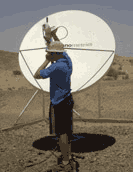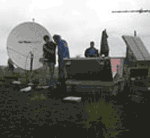|
|
|
|
|
|
|
|
Libra is the world's leading VSAT communications technology for seismic and environmental monitoring networks. Libra technology is used in over 90% of the world's VSAT based seismograph networks.
Libra remote field stations allow for complete freedom in station placement, use the same essential configuration for all applications, and are backed by a single company which understands the objectives and importance of seismic data acquisiton.
Freedom in station placement

With Libra, Nanometrics offers a VSAT-based system with extremely low power consumption, now making this proven technology viable for transmission of high volumes of environmental data from virtually any remote site. Low power consumption (less than 18 Watts) allows remote stations to be solar-powered and completely self-contained, with no reliance on conventional infrastructure.
Sites can be installed at any location with a clear view of the satellite, allowing Libra networks to be located in hostile or isolated terrain unsuited to telephone or radio communications. Satellite coverage can easily be matched to your local, regional or national network needs.
Nanometrics has more than 15 years' experience designing and deploying digital seismograph systems, with over 120 networks installed in 40 countries. With Libra, Nanometrics can provide a network tailored to your seismic or other environmental data acquisition requirements free of the limitations imposed by terrestrial communications systems. On deployment, Libra networks are cost-effective to operate and maintain, while providing high data integrity. |
|
Simple to deploy, reliable to operate
The nature of a VSAT system is such that there is no need for repeaters. Every Libra system uses the same basic elements, making installation, commissioning, and maintenance easy. Networks can be installed and operated after a few days of training.
 The remote site equipment is housed in a single outdoor unit and requires no integration. The lightweight package and small Ku-band antenna are easily transported and can be installed in a few hours.
Most sites are easily powered by solar arrays as the complete site, including digitiser and seismometer, typically consume less than 20 watts. Low power is critical to network reliability. Perhaps less obvious is the importance of robust electronics capable of operating in the harsh weather extremes typically experienced at remote sites. Unlike most VSAT systems, Libra remote sites consist of a single outdoor unit designed to operate over a wide temperature range and to survive the weather year in and year out.
Extremely economical to operate
Choosing a Libra system is a sound business decision. In most countries, network costs are as low as $40/station/month for continuous high quality 24-bit data. A common equipment set for all stations combined with solar power operation reduces spare parts requirements and simplifies network maintenance.
A Libra network can be operated for as little as US $5800 per year, or only $40/station/month. This is based on a typical 16-stations transmitting continuous 3 ch data at 100 sps over an Intelsat 100 kHz lease, at a ten-year lease rate of $5800. Larger networks are just as economical, due to Libra's use of efficient QPSK (quadrature phase shift keying) modulation and TDMA (time domain multiple access) protocol.
Libra networks are economical to maintain. Each Libra remote site is identical in its hardware configuration, reducing spare parts inventory and requirements for technical training. Since there are no repeater sites, network planning is less costly. Once installed, there are fewer remote locations to inspect and service. Libra has lower operating costs than networks using telephone lines, with cost savings achieved and maintained within 12 to 14 months.
|
|
|
|
|
|